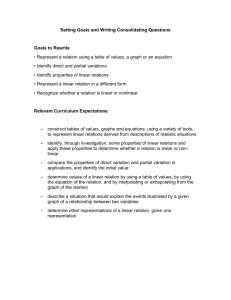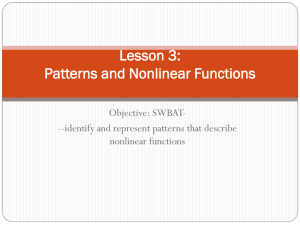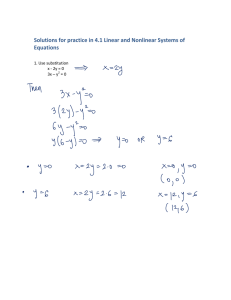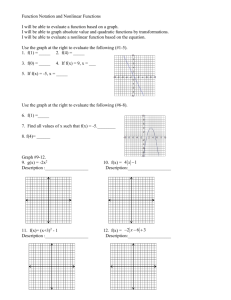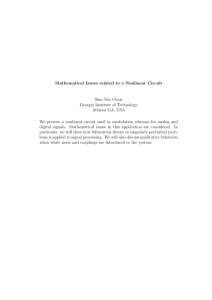Scaling
advertisement
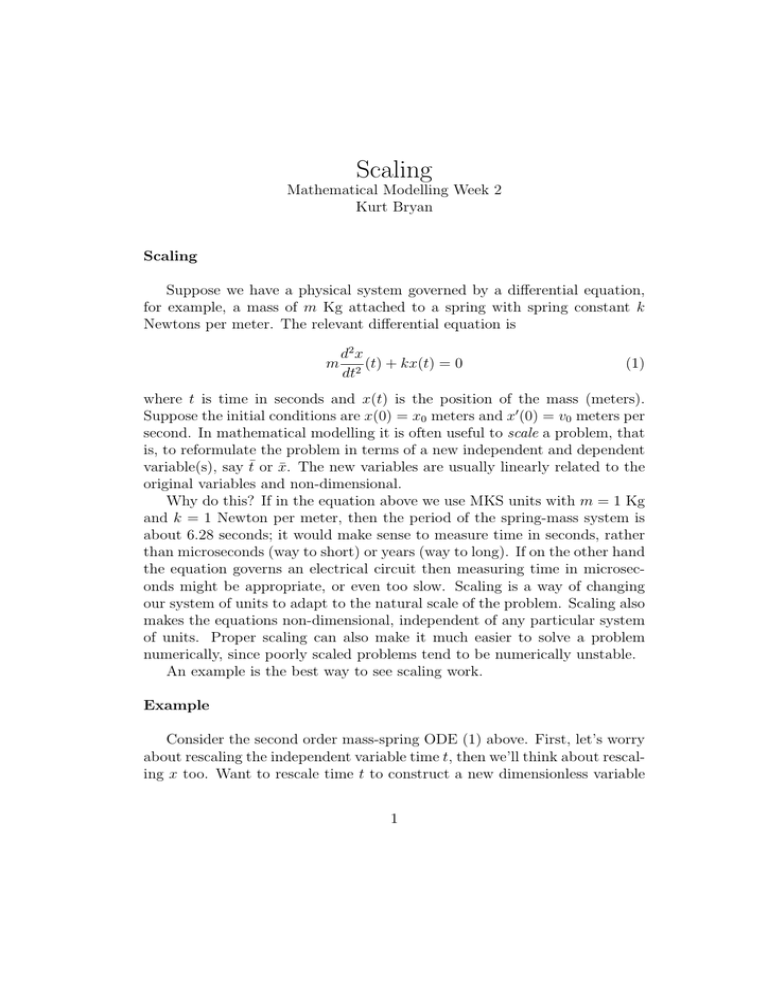
Scaling Mathematical Modelling Week 2 Kurt Bryan Scaling Suppose we have a physical system governed by a differential equation, for example, a mass of m Kg attached to a spring with spring constant k Newtons per meter. The relevant differential equation is m d2 x (t) + kx(t) = 0 dt2 (1) where t is time in seconds and x(t) is the position of the mass (meters). Suppose the initial conditions are x(0) = x0 meters and x0 (0) = v0 meters per second. In mathematical modelling it is often useful to scale a problem, that is, to reformulate the problem in terms of a new independent and dependent variable(s), say t̄ or x̄. The new variables are usually linearly related to the original variables and non-dimensional. Why do this? If in the equation above we use MKS units with m = 1 Kg and k = 1 Newton per meter, then the period of the spring-mass system is about 6.28 seconds; it would make sense to measure time in seconds, rather than microseconds (way to short) or years (way to long). If on the other hand the equation governs an electrical circuit then measuring time in microseconds might be appropriate, or even too slow. Scaling is a way of changing our system of units to adapt to the natural scale of the problem. Scaling also makes the equations non-dimensional, independent of any particular system of units. Proper scaling can also make it much easier to solve a problem numerically, since poorly scaled problems tend to be numerically unstable. An example is the best way to see scaling work. Example Consider the second order mass-spring ODE (1) above. First, let’s worry about rescaling the independent variable time t, then we’ll think about rescaling x too. Want to rescale time t to construct a new dimensionless variable 1 t̄ according to t (2) tc where tc is some constant with the dimension of time. The constant tc is the time-scale of the original problem, and should reflect how quickly or slowly things happen in the physical process. The physical constants in the DE are m, k, and A with dimensions [m] = M , [k] = M T −2 , and [A] = L. It seems reasonable that the time scale tc should depend on these physical parameters, so we try to form tc from m, k, and A as tc = mα k β Aγ . If dimensions are to balance, this means that t̄ = [mα k β Aγ ] = M α M β T −2β Lγ = T so that α + β = 0, −2β = 1, and γ = 0. This forces α = 1/2, β = 1/2, γ = 0. We then have r m tc = k as the natural time scale for the problem. The new independent variable will q be t̄ = t/ m as defined by equation (2). Note that t̄ is dimensionless. k This changes the DE. Define the function x̄(t̄) = x(t) = x(tc t̄); x̄ is just x measured in our new system of units. Then by the chain rule dx̄ dx = tc , dt̄ dt 2 d2 x̄ d x 2 = t . c 2 dt̄ dt2 The DE for x(t) becomes, in terms of x̄(t̄), d2 x̄ (t) + x̄(t̄) = 0 dt̄2 (3) with initial conditions x̄(0) = A, x̄0 (0) = 0. Exercise: Carry out a similar analysis, this time trying to scale x instead of t. we can then define X(t̄) = x(t)/xc = x(tc t̄)/xc , where xc is some constant with dimension length, formed from m, k and A. The new DE should still be the same as equation (3) but now with initial conditions X(0) = 1, X 0 (0) = 0. 2 Because the variables t̄ and X are dimensionless, we say that this problem has been reduced to dimensionless form. The solution to (3) is of the form X(t̄) = c1 sin t̄ + c2 cos t̄. Scaling the problem gives valuable insight into the physics of the problem. For example, if we intend to measure X(t̄) periodically in order to estimate the motion of the system, we might need to measure about 20 times over one cycle of length 2π, so that we’d measure X three times for every unit change in t̄. This q means that in the original problem we’d need to measure x(t) about 3tc = 3 m/k times per unit change in t. Problems: 1. A ball of mass m is dropped from some height. Let’s assume that the force on the ball is due to gravity mg plus air resistance, and that air resistance is proportional to velocity v(t), so the force of air resistance is −kv(t) for some positive constant k. From Newton’s Second Law F = ma we obtain mg − kv(t) = mv 0 (t), or v 0 (t) = g − k v(t). m If the ball is dropped at time zero then v(0) = 0. Find the dimensions of the constants m, g, and k. What is the appropriate time scale tc for this problem, in terms of g, k, and m? What is the appropriate scale vc for v itself? After you find tc and vc , define a rescaled dimensionless velocity V (t̄) = v(tc t̄)/vc , where t̄ = ttc is dimensionless time. Find the DE satisfied by V . Hint: it has no constants left in it at all. If the ball has a mass of 0.1 Kg and a terminal velocity of 70 meters per second, are the constants tc and vc ? 2. A decent model for the growth of the U.S. population from 1790 to 1950 is given by the first order DE (see Braun, Differential Equations and Their Applications, section 1.5) dx = ax(t) − bx(t)2 dt with a = 0.03134 and b = 1.5887×10−10 . The units on a are years−1 and the units on b are years−1 people−1 (so the dimensions in this problem 3 are time and “people”). What is an appropriate time scale tc for this for this problem in terms of a and b?. What is the appropriate scale xc for x? What is the rescaled differential equation? Dropping Negligible Terms One of the more important uses of scaling is to help us decide when certain parts of a model or certain terms in the governing equations are small and therefore “negligible.” When the governing equations for a system are nonlinear we often want to drop the nonlinear terms, but this is valid only if their effect is small enough. Proper scaling helps to quantify how small they should be. Consider a spring-mass oscillator with a nonlinear spring. Let the displacement of the mass from its rest position be denoted by x(t), where t is time. The mass is m and the spring exerts a restoring force equal to −kx − bx3 , a so-called “hard” spring; this spring is nonlinear. Suppose the mass is displaced by an amount A and released with no initial velocity at time t = 0. A simple F = ma argument shows that the governing DE and initial conditions are mx00 + kx + bx3 = 0, x(0) = A, x0 (0) = 0. This equation is nonlinear and can’t be solved in any simple closed form. However, if the nonlinear bx3 term wasn’t present then this would be a simple harmonic oscillator. Can we safely ignore that term? Let’s consider the case where m = 1, k = 1, b = 0.01 and A = 10 in some system of units. In this case it appears that the nonlinear bx3 term is quite small; maybe we really can ignore it. Exercise: Use computer package to solve the above equation with k = 1, m = 1, b = 0.01, A = 10 for t = 0 to t = 10. Solve again without the bx3 term. Did the nonlinear term make much difference? Now let’s try scaling the problem. There is one obvious choice for scaling the length of the problem, and it is xc = A, the initial displacement. To scale 4 with respect to time we look for a quantity tc = k α bβ mγ Aδ with dimension time. The usual analysis leads to √ tc = k −β−1/2 bβ mA2β where β can q be any number. Let’s take the simplest choice, β = 0, so that tc = m/k, just as for the harmonic oscillator. Now define x̄(t̄) = x(t)/xc = x(tc t)/xc . The chain rule shows that d2 x̄/dt̄2 = t2c /xc d2 x/dt2 . Plugging all this into the DE satisfied by x shows that x̄ satisfies the scaled non-dimensional equation x̄00 + x̄ + ²x̄3 = 0, x̄(0) = 1, x̄0 (0) = 0, where ² = bA2 /k. Note that ² is dimensionless. It’s now clear when the nonlinear term can be neglected; we need ² << 1. This gives the condition bA2 << 1 k (4) for dropping the nonlinear term. Exercises: 1. What was ² for the specific choices of constants in the previous exercise? Adjust the value of one of A, b, or k to make ² = 0.01 and redo the previous problem (compare the solutions to the linear and nonlinear problem). Do the solutions to the nonlinear and linearized equations have better agreement? 2. Suppose a mass m on a spring with restoring force −kx experiences a friction or resistive force equal to −bx0 . The initial conditions are x(0) = A, x0 (0) = 0. Rescale the problem to the nondimensional form x00 +²x0 +x = 0 with appropriate initial conditions. What is ² in terms of k, b, A? Compare the damped and undamped solutions for a few values of ², say over the first 5 cycles. Under what conditions (analogous to equation (4)) on b, k, A can we reasonably ignore the damping for 5 cycles? 5

